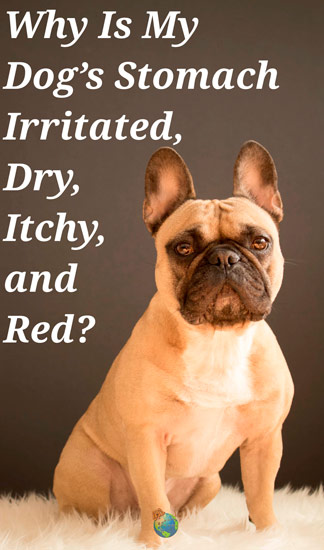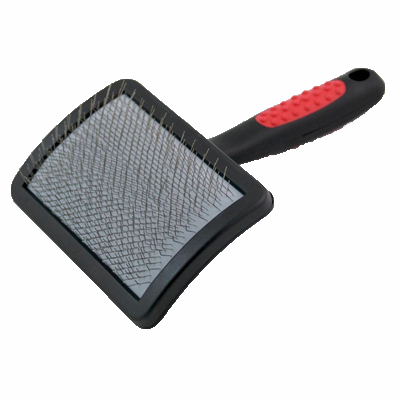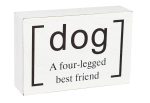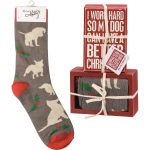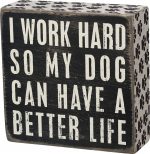There are several reasons why your dog may scratch at their stomach. First, you’ll need to look closely at your dog’s stomach; what you see will help determine the cause of the itch.
Reasons Why Your Dog’s Stomach May Be Irritated
- Fleas
- Foreign Object (thorn, leaves)
- Ticks
- A rash (small red bumps)
- Dry skin (small white flakes)
- Scabs/New or old blood
- Hair Knots
- Sap
Each of the above listed scenarios will require unique steps to solve your dog’s itching.
Fleas
The quickest way to resolve a flea problem is to bathe your dog with a special shampoo that kills fleas. Resist the urge to pick the fleas from your dog’s coat/skin. Picking the fleas one by one will not rid all of the fleas from your dog’s coat and it may further agitate your dog! Fleas feed on your dog by biting through the skin and sucking blood. After you bathe your dog, give enough time for the coat to dry. Check again for any fleas that may have survived. If you still see fleas, follow the directions on the bottle and give your dog another bath. Many shampoos require you to soak for a few minutes so the medicine penetrates the fur and kills the fleas. This should rid your dog of all fleas.
If you do not see fleas do not use flea shampoo. Flea shampoo can actually worsen a rash if the irritation is due to another cause. Flea medicine is a good idea if your dog goes
Ticks
If you see a tick, prepare to remove it. It is possible for your dog to have a tick even if you can’t see it. Ticks like to burrow themselves under a dog’s skin. If the tick is burrowed, it is best to seek advice from your vet to have it professionally removed. To remove the tick on your own, the following tools should be used for a safe and clean removal: gloves, tweezers, and an antiseptic (rubbing alcohol/hydrogen peroxide are most common). Antiseptics reduce the risk of infection and help sterilize the area. While wearing gloves, grab as much of the tick as you can with tweezers and pull straight out. Be sure not to dig at or pinch your dog’s skin which can cause further irritation. Once you remove the tick, you should kill it with alcohol.
Finally, clean the area of your dog’s skin where the tick was attached with the alcohol. Keep an eye on your dog’s behavior for the next week. Ticks can cause illness, which include symptoms like fatigue, loss of appetite, and swollen joints. If you see your dog having any of these symptoms, seek veterinarian attention.
Rashes
Several irritants could cause a rash. Your dog may be having a food allergy, an environmental allergy, an infection, or mites. You will be able to tell if the rash your dog has is itchy or painful by watching your dog’s actions. Excessive scratching, licking of the paws, shaking of the head, biting of the paws/tail, and rubbing up against objects all indicate an itchy rash. You can either have your dog tested for food allergies or you could put your dog on a strict diet to eliminate allergenic foods.
Common Allergies & Elimination Diet
Some dogs are allergic to beef, soy, dairy, fish, chicken, wheat, corn, eggs, or yeast. Unfortunately all of these foods are common in dog food. You will want to start an elimination diet for your dog. This consist of feeding them new foods that they have never had before and eliminating all food they normally eat. If your dog eats a variety of foods and you don’t think you will be able to pinpoint specific allergens then eliminate all foods and slowly introduce each food back into your dog’s diet week by week. This will take time but it will give you a greater chance of finding a solution for your dog.
One week try sweet potatoes, the next week try sweet potatoes and chicken. Then the next week try sweet potatoes, chicken and rice etc. If your dog’s rash clears up or comes back, you will be able to tell which food your dog is allergic to.
Environmental allergies include grass, dust, weeds, and mold, which are all very similar to human allergies. Your dog should be tested for allergies since it is difficult to control and isolate these allergens. Your dog may be prescribed an allergy medicine or Benadryl. These medicines reduce swelling and irritation. 1 mg of Bendryl per pound can be given.
Skin Infections
A skin infection is easier to pinpoint. Skin infections are usually red, bumpy, and often a secretion is present. You can give your dog a bath with an antibacterial shampoo to help clean and clear up the infection.
Dry Skin
Dry skin may be due to living in a low moisture region (think New England during the Winter). Many feel the urge to give their dog a bath when they see dry skin or dandruff. Contrary to popular belief, bathing your dog will actually dry out your dog’s skin even more. You should apply hydro-cortisone cream to reduce the urge to scratch. Also, you will want to check your dog’s food has essential omega oils and fatty acids. Having these oils in your dog’s diet is essential to maintaining a healthy coat and skin. Moisturizing sprays are also available which contain natural oatmeal, fatty acids, and glycerin, all of which sooth
Scabs
Determine the cause of the blood or the blood that has dried and turned into a scab. Clean the area well with hydrogen peroxide. Some recommend a 50/50 mix of warm water and peroxide to reduce the stinging effect. Make sure the cut or scab does not look infected. The Vet should tread infected areas or deep cuts. You should also take your dog to the Vet if you are not sure of the cause. Your dog could have come in contact with another animal, a rusty nail, or something that could be hazardous if it were to
Hair/Knots
Lack of brushing or grooming can cause knots in your dog’s hair. Dogs with undercoats are especially prone to knots in their fur. Knots that are close to the skin pull as they get tighter, causing irritation and itchiness. You can shave your dog’s coat or cut to clean up the coat and remove knots. If cutting is not an option you can gently remove the knots with a slicker brush and a conditioner. Gently try to brush and work out as many knots as you can then give your dog a bath. After the bath, apply plenty of dog conditioner and use the slicker brush to slide through your dog’s undercoat.
Sap
Remove sap as soon as you find it on your dog’s coat. It will become harder to remove the longer you wait. If the sap is on the edges of your dog’s fur then carefully trim it away with scissors. If trimming is not an option you can try a sap remover, olive oil, mayonnaise, or peanut butter. All of these items have a high oil content. Therefore the oil softens the sap and breaks down it’s stickiness. Work your item of choice
Foreign Object
If you find a thorn or twig in your dog’s coat, gently remove the object. But, infected objects such as thorns should be removed by a professional.
Kimberly Mattar
January 15th, 2014
Latest Update: August 28th, 2020

Kim is the co-owner of DogLoverStore with her husband, John. She earned her BS in operations management at the University of Massachusetts Dartmouth. She enjoys walking in nature, gardening in the sun, eating sour candy, going on drives, yoga, and reading.

